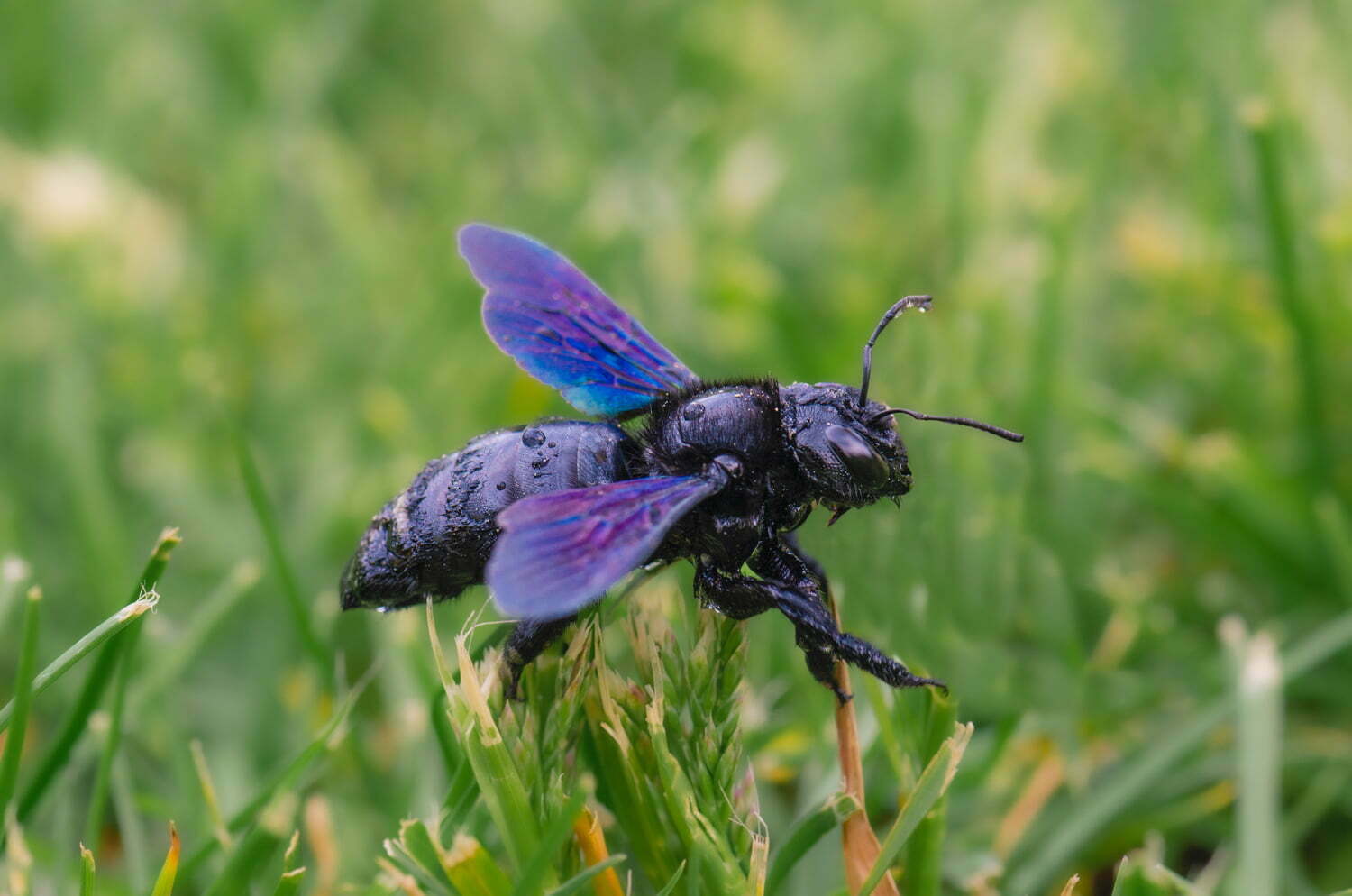
Bee infestations typically refer to the presence of a colony or nest of bees in or around a structure, such as a home, tree, or building. While bees play a crucial role in pollination and the ecosystem, certain species can become a nuisance or pose risks when nesting near human habitats. Common bee species that may infest structures include honeybees, bumblebees, and carpenter bees. Bee infestations can lead to structural damage, stinging incidents, and allergic reactions. It’s essential to address bee infestations safely and responsibly, either by relocating the colony with professional beekeepers or seeking assistance from pest control experts when necessary.
Understanding Carpenter Bee Behavior: Carpenter bees are solitary insects that bore holes into wood to create galleries for nesting. They are notorious creatures capable of boring into wood, causing structural damage and aesthetic problems for homeowners. Unlike honeybees, they don’t live in colonies. Male carpenter bees are aggressive but lack stingers, while females can sting but are less aggressive. Understanding their behavior is crucial for effective control.
Identifying Carpenter Bees: Carpenter bees resemble bumblebees but have a few distinctive features. They are large, with shiny, black abdomens and a lack of yellow markings. Female carpenter bees have a stinger but are less likely to sting than other bee species.
Signs of Carpenter Bee Infestation: Identifying carpenter bee infestations early is vital. Signs include:
- Round Entry Holes: Small, perfectly round holes about the diameter of a pencil are bored into wood.
- Sawdust Piles: Carpenter bees push sawdust and debris out of their nests, creating small piles below entry holes.
- Hovering Bees: Male carpenter bees often hover around nesting sites, defending them aggressively.
- Wood Damage: Over time, carpenter bee activity can weaken and damage wooden structures.
How To Treat Bee Sting
Treating a bee sting is essential to reduce pain and swelling. Follow these steps:
- Remove the Stinger: Scrape the stinger out gently using a credit card or your fingernail. Do not use tweezers, as it can squeeze more venom.
- Wash the Area: Clean the sting site with soap and water.
- Cold Compress: Apply a cold compress or ice wrapped in a cloth for 15-20 minutes to reduce swelling and pain.
- Pain Relief: Over-the-counter pain relievers like ibuprofen or acetaminophen can help alleviate discomfort.
- Antihistamines: If itching and swelling persist, consider taking an antihistamine like Benadryl.
- Keep an Eye: Watch for signs of an allergic reaction. If severe swelling, difficulty breathing, or other symptoms occur, seek immediate medical attention.
How To Get Rid Of Bees Without Killing Them
To get rid of bees without harming them, consider these humane methods:
- Bee Repellents: Use natural bee repellents like citronella candles, mint, or cinnamon around the bee-prone areas.
- Relocation: Contact a local beekeeper or bee removal experts to safely relocate the bee colony.
- Bee Traps: Place bee traps or bee-friendly bait stations away from your living areas to lure the bees away from your home.
- Seal Entry Points: Prevent further infestations by sealing gaps and cracks in your home’s structure where bees enter.
- Plant Deterrents: Plant bee-repelling flowers and herbs like marigolds, basil, or mint around your property.
By using these methods, you can encourage bees to relocate naturally without causing harm to them.
Also Read: Things to Know About Bee Control Melbourne
Natural Carpenter Bee Control Methods:
- Paint or Stain Wood: Carpenter bees prefer untreated wood; painting or staining wood surfaces can deter them.
- Plug Holes: Once carpenter bees have vacated their nests, plug the holes with wooden dowels and wood putty.
- Citrus Oil Spray: Citrus oil sprays can deter carpenter bees; apply them to wooden surfaces.
- Aluminium Foil: Wrapping infested wood with aluminum foil can discourage bees due to the noise and disruption.
- Hang Swings or Wind Chimes: Vibrations from swings or wind chimes can deter carpenter bees from nesting in the vicinity.
- Professional Extermination: Consult a pest control expert for targeted treatments and long-term prevention.
Chemical Carpenter Bee Control Methods:
- Dust Insecticides: Dust insecticides like carbaryl or boric acid can be injected into nest openings to kill carpenter bees.
- Liquid Insecticides: Liquid insecticides can be applied to wood surfaces, creating a barrier that repels carpenter bees.
- Professional Pest Control: Pest control experts have access to specialized equipment and treatments to effectively eliminate carpenter bee infestations.
Preventing Carpenter Bee Infestations: Prevention is key to avoiding future carpenter bee problems:
- Paint or Stain Wood: Cover exposed wood surfaces with paint, stain, or varnish.
- Seal Entry Points: Fill holes and gaps in wood where carpenter bees might nest.
- Regular Inspections: Routinely inspect your property for signs of carpenter bee activity.
- Wood Replacement: Consider replacing infested wood with alternative materials less attractive to carpenter bees.
Carpenter bees can cause significant damage to wooden structures, making effective control essential. By understanding their behavior, identifying signs of infestation, and implementing natural or chemical control methods, you can protect your property from these destructive insects. Whether you choose DIY approaches or enlist professional pest control services, the goal is to eliminate carpenter bees effectively and prevent future infestations, ensuring the longevity and beauty of your wooden structures. For professional services call Pest Free Nests professionals now.
FAQ –
Does A Bumble Bee Sting?
Yes, bumble bees can sting. While they are generally less aggressive than some other bee species, such as honeybees or wasps, bumble bees can sting if they feel threatened or if their nest is disturbed. Bumble bee stings are usually painful but not typically dangerous unless the person stung has an allergic reaction. The stinger is barbed, and when a bumble bee stings, it may leave the stinger behind, which can continue to deliver venom. It’s important to treat a bumble bee sting promptly to reduce pain and swelling.
How do you get rid of carpenter bees fast?
To swiftly eliminate carpenter bees, Pest Free Nests employs effective strategies, including pinpointing entry points, using specialized insecticides, sealing holes, and offering preventative measures like wood treatments. What sets Pest Free Nests apart is our commitment to eco-friendly solutions, ensuring safety for your family and the environment. We prioritize long-term results, safeguarding your property from future infestations. With our expertise and dedication to customer satisfaction, choosing Pest Free Nests means choosing a swift, efficient, and environmentally responsible solution to carpenter bee problems.
What will keep carpenter bees away?
To deter carpenter bees:
- Paint or Stain Wood: Cover exposed wood surfaces with paint, stain, or varnish.
- Use Pressure-Treated Wood: Consider using pressure-treated or naturally resistant wood.
- Hang Wind Chimes: Vibrations can discourage carpenter bees.
- Apply Citrus Oil: Citrus oil sprays on wood surfaces can repel them.
- Regular Maintenance: Routinely inspect and seal holes or cracks in wood.
These measures help prevent carpenter bees from nesting in your property.
What works best to get rid of carpenter bees?
When dealing with a persistent carpenter bee infestation, professional help is often the most effective solution. Pest control experts possess the knowledge, tools, and targeted treatments required to eliminate carpenter bees efficiently. They can locate and treat nesting sites, ensuring the complete removal of these pests. Moreover, professionals can provide preventative measures to deter future infestations, safeguarding your property from potential damage. Choosing professional assistance is the best way to address carpenter bee problems swiftly and effectively while ensuring long-term protection.
For any questions or to schedule a consultation, please contact us at Phone: 0423 624 888




